Leave a sound environment to future generations
- Yokohama Forever Forest activities
- Building a sustainable supply chain 1
- Building a sustainable supply chain 2
- Energy-saving and natural energy use
We provide opportunities to come into contact with nature and to learn from nature

Results of initiatives
The results of the Yokohama
Forever Forest project:
No. of trees planted + No. of saplings donated
852,335saplings planted and donated
(As of December 31, 2017, consolidated)
Yokohama Forever Forest – Moving on to the next step
What is the Yokohama Forever Forest project?
The Yokohama Forever Forest was initiated as a project to plant
500,000 saplings which selected by the theory of potential natural
vegetation in our Yokohama Rubber Group factories and sales
locations around the world by 2017, the year that marked the 100th
anniversary of the founding of Yokohama Rubber. This project
intended to achieve as follows: Developing participants’ environmental
awareness; Disaster prevention, and forming environmental
conservation forests; Helping decelerate global warming; Conservation
of biodiversity; and Communicating with regional communities. The
project was about more than just planting trees; we undertook this
project as “Regeneration of indigenous forest to help protect lives,” for
the global environment and for local communities.
A key aspect of the Yokohama Forever Forest project is that it
involves the participation of all Yokohama Rubber Group employees.
All of the work – such as collecting acorns, planting them in pots,
applying fertilizer to and watering the saplings in the pots, building
the mounds of earth in which the trees will be planted, to the actual
tree-planting and the subsequent maintenance work, etc. – is
undertaken through the sweat and toil of Group employees
themselves, working together to bring the project to fruition.
Goal achievement status
The Yokohama Forever Forest project was launched on November
11, 2007 with the first tree-planting at the Hiratsuka Factory. Since
then, tree-planting has been carried out at 14 Yokohama Rubber
Group business locations in Japan and at 20 Group business
locations in 8 countries overseas. The goal of planting 500,000
trees was reached in September 2017. After achieving this target,
we have continued to carry out tree-planting, and as of December
31, 2017 the total number of trees planted had reached 525,662.
Besides planting trees in the grounds of factories and other
Yokohama Rubber group facilities, we have also donated saplings
to local municipalities, schools, other business enterprises, etc. free
of charge, and provided guidance on tree-planting. As of
December 31, 2017, the total number of trees donated in this way,
in Japan and overseas, came to 326,673.
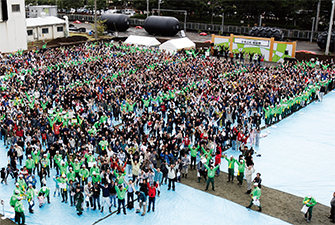
The 1st Tree Planting Festival, held at the Hiratsuka Factory in November 2007
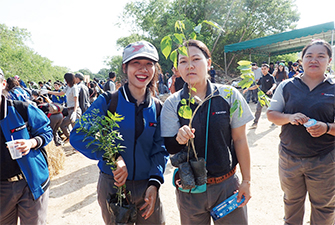
Tree planting at Yokohama Tire Manufacturing (Thailand) Co., Ltd. (YTMT)
Future goals
The Yokohama Forever Forest project is also helping to safeguard the genetic diversity of local tree species and to maintain and restore local ecosystems. By providing trees for a particular locality, once the trees have grown they will provide a habitat for insects, birds, etc.
If these habitats can then be linked together, so that creatures can move easily between them, then this can help to enrich the ecosystem of the entire region.
In addition, building on the experience gained in the creation of
the “Heisei Forest” at Otsuchi-cho in Iwate Prefecture, the Yokohama
Forever Forest project has also contributed towards the creation of
forested embankments (Green Tide Embankment) that can help to
protect human life in the event of a natural disaster, and towards
disaster prevention and disaster response awareness-raising.
By making effective use of the knowledge that has been
accumulated through the implementation of the Yokohama Forever
Forest project, we intend to continue with the implementation of
related measures, focusing on the donation of tree saplings and the
provision of tree-planting know-how, with the aim of contributing
towards the conservation of biodiversity in local communities.
Through this continued implementation, we intend to realize the
goal of having a grand total of 1.3 million trees planted by 2030
(including both the trees that have been planted and donated so far
and future tree plantings and saplings donations).
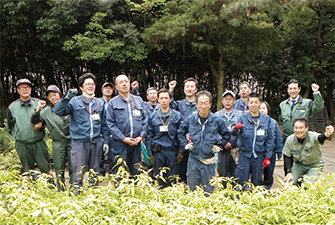
Ceremony held to mark the donation of saplings to the Shinwa Gakuen Institute
The “Education Forest” concept
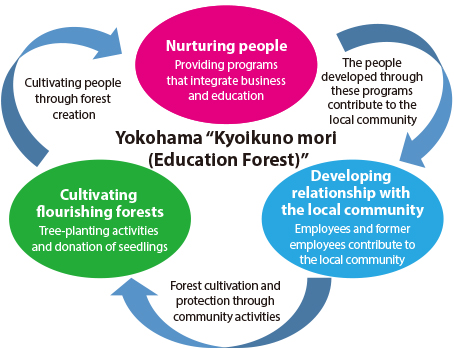
The aims of the “Kyoikuno mori (Education Forest)” project
To further develop the “Developing participants’ environmental awareness” and “Communicating with regional communities” aspects of the Yokohama Forever Forest project, Yokohama Rubber has decided to implement a new “Kyoikuno mori (Education Forest)” project. This project will involve utilizing various different forms of educational content provision, including visiting lectures, to provide children at local schools with the techniques and knowhow that we have accumulated; our goal is to provide the children with a “way in” to adventures in new worlds of knowledge, and with an opportunity to acquire wisdom that will help them to live fulfilling lives.
Goals, and anticipated implementation items
We provide content aimed at kindergarten and nursery school children, elementary school and junior high school students, senior high school students, and teachers.
The programs that we are currently providing
- Road safety etiquette classes
- Rubber’s functions
- Acorn handicrafts and tree seedling cultivation
- “Let’s plant trees!” activity
Future objectives
The “Education Forest” project provides easy-to-understand educational programs that use Yokohama Rubber’s products and services, and the tasks that Yokohama Rubber has to implement in order to provide these products and services, as the basis for the teaching materials. The aim is to get children looking at things from a scientific perspective, to make them more observant and to awaken their interests. We also hope that the project will help to enrich students’ lives, and that the communication between Yokohama Rubber employees and local communities can plant the seeds for the development of new technologies and new knowledge in the future.
TOPIC
Cultivating local communities’ next
generation through
the “Education Forest” project
Implementing the “Acorn Handicrafts and
Tree Seedling Cultivation” visiting class
In April 2018, Yokohama Rubber’s Shinshiro Plant organized
an “Acorn Handicrafts and Tree Seedling Cultivation”
visiting class for 1st grade and 2nd grade students at the
Shinshiro Municipal Yana Elementary School. Shinshiro
Plant employees acted as instructors for the class. In the
acorn handicrafts part of the class, the instructors showed
the children how to make floral wreaths for Children’s Day,
while in the tree seedling cultivation part of the class they
showed them how to plant tree cuttings in pots.
The School Principal commented that “Children in the
younger grades are full of curiosity and eager to learn. I feel
that having people from outside the school come in to
teach them is a very good thing, as it is very stimulating for
the children. I hope that we will be able to host more
visiting classes like this in the future.”
This was the fifth time that the “Acorn Handicrafts and
Tree Seedling Cultivation” visiting class had been held at
Yana Elementary School. In the future, Yokohama Rubber
will continue to actively implement activities that can help
to build a friendly relationship of trust with local
communities, focusing on the goals of “Cultivating
flourishing forests,” “Cultivating people,” and “Cultivating
links with the local community.”
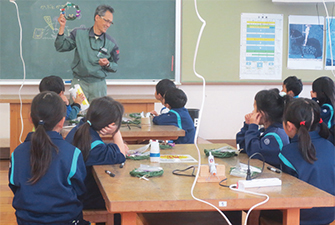
Acorn handicrafts class in progress
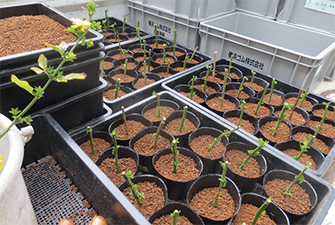
The tree seedlings that the children planted
We are working, through our business operations, to make natural rubber a sustainable resource

Results of initiatives
Number of suppliers
participating in Suppliers Day
42 participants from 25 companies(in 2018)
Measures implemented by the Yokohama Rubber Co., Ltd.
SNR-i’s 5 objectives
- Supporting the improvement of natural rubber plantations’ productivity
- Enhancing natural rubber quality
- Supporting forest sustainability
- Demonstrating appropriate water management
- Demonstrating the highest respect for human and labour rights
Yokohama Rubber supports the Sustainable Natural Rubber Initiative (SNR-i)
Yokohama Rubber supports the goals of, and participates in the
activities of, the Sustainable Natural Rubber Initiative (SNR-i)
launched by the International Rubber Study Group (IRSG), an
inter-governmental organization composed of rubber producing
and consuming stakeholders.
The World Business Council for Sustainable Development
(WBCSD) has also begun discussion and examination of the issue of
sustainable natural rubber through its Tire Industry Project (TIP).
Yokohama Rubber will be fulfilling its responsibilities as a member
of the WBSCD’s TIP.
With both the global population and the number of motor
vehicles per head of population continuing to increase, demand for
tires is expected to grow continuously into the future. Since it can
therefore be assumed that demand for natural rubber will also
increase, with recognition for its responsibility to society as a
manufacturer of tires and other rubber products. Yokohama
Rubber is working actively to promote these projects.
The goal of promoting CSR activities throughout the value chain
forms an important part of the Yokohama Rubber Group’s CSR
Materiality. Starting from 2014, we have been surveying
conservation of biodiversity and human rights protection status
etc. in natural rubber farm in Thailand and Indonesia. In addition,
the Group’s natural rubber processing subsidiary in Thailand has
been encouraging farmers to adopt the agroforestry practices,
which cultivate 10 or more different species – including bamboo,
fruit trees, etc. – together with natural rubber trees. In the
following sections, we present some examples of the CSR
activities that Yokohama Rubber has been implementing through
the value chain.
Implementation of supplier meetings for natural rubber suppliers
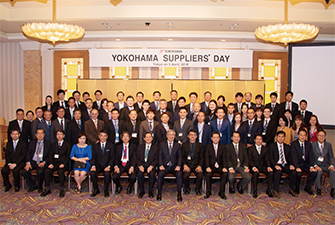
Suppliers Day
In April 2018, the Yokohama Rubber Group held its 2nd Suppliers
Day meeting for natural rubber suppliers. A total of 42
representatives of 25 companies in 5 countries attended the
meeting, at which Yokohama Rubber requested the suppliers’
assistance in regard to the implementation of measures aimed at
making natural rubber a sustainable resource, in line with our CSR
policy; the Suppliers Day event helped to lead to strong mutual
understanding with suppliers.
Natural rubber is produced mainly in Southeast Asian countries,
including Thailand, Indonesia, Vietnam, etc. Most natural rubber is
not produced on large-scale plantations, but rather on large
numbers of small-scale farms (smallholders).
With the aim of conservation of biodiversity and minimizing the
impact of climate change, Yokohama Rubber has been working
together with suppliers to ensure traceability and to maintain
transparency in the supply chain.
During the Suppliers Day meeting, Yokohama Rubber gave a
presentation on the agroforestry project that we are implementing
in the Surat Thani district of Thailand. Using a video message,
Professor Sara Bumrungsri of the Prince of Songkla University, who
has been providing Yokohama Rubber with guidance to support
the diffusion of agroforestry, explained the agroforestry measures
that we have been implementing, and discussed recent findings
from his research.
With the aim of ensuring sustainable production of natural
rubber that is in harmony with the natural environment, we will
continue to implement measures that build a win-win relationship
with farmers that helps farmers to maintain their financial
autonomy.
Measures implemented at our natural rubber processing plant (YTRC)
YTRC’s water cycle measures
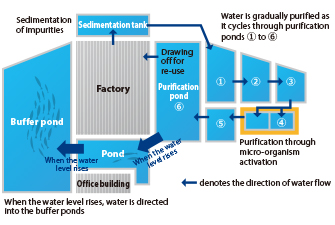
YTRC’s water-recycling system
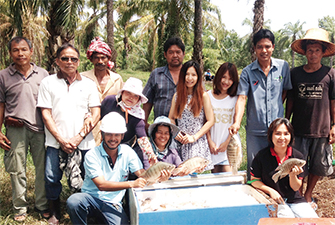
Making the buffer pond open to the public so that local residents can use it
Y. T. Rubber Co., Ltd. (YTRC) is Yokohama Rubber’s Thai rubber
manufacturing subsidiary. When the YTRC plant first began operation,
we signed an agreement with the local community undertaking not
to allow any of the water used in the plant to be discharged outside
the plant; we have been using a water cycle system that enables water
to be repeatedly reused. YTRC uses two types of rubber raw material
to manufacture Standard Thai Rubber (STR); water is used mainly in
the process of washing these raw materials.
YTRC has a sedimentation tank and six purification ponds inside
the factory premises; water cycles through these and is reused.
YTRC has a sedimentation tank and six purification ponds inside
the factory premises; water cycles through these and is reused.
Water that has been used in the manufacturing process is first
transported to the sedimentation tank, where non-soluble
substances are deposited. The water then cycles through the six
purification ponds, where microorganisms are used to purify the
water. One of these ponds is fitted with equipment for stirring the
water for a set period of time so as to mix air in with the water,
which accelerates the process of purification by microorganisms. The purified water is then used again in the manufacturing process.
The water in the purification ponds is sampled on a regular basis
to analyze the water quality, which facilitates proper management.
When the water level in the purification ponds rises because of
heavy rains, the ponds located adjacent to the office building and
the buffer pond function as overflow reservoirs, preventing the
washing water from overflowing outside.
In order to allow this water cycle purification system using
sedimentation and microorganisms to operate at full effectiveness,
with regard to the washing water used in the plant, valves can be
turned off whenever any of the production process equipment is
shut down, and the amount of water drawn off from the ponds is
automatically reduced, so that the overall amount of water being
used can be properly controlled. This method enables the amount of
water needed in the water cycle to be reduced by around 30%;
furthermore, by increasing the amount of time that the water spends
in the sedimentation tank and being purified by microorganisms, it
also improves the water quality and reduces energy consumption.
For domestic water other than drinking water, the plant uses
river water that has undergone chemical treatment, filtering, and
sterilization treatment. The roof of the water storage tank used to
store the processed water has been modified to collect rainwater;
by using rainwater, the amount of river water that is needed can
be reduced. Domestic wastewater passes through the septic tanks
and purification ponds before being reused as washing water in
the plant.
The buffer pond has the same species of fish living in it as the
nearby Tapi River. It would be fair to say that the retarding basin
provides an alternative habitat for the Tapi River organisms, and
thus contributes to safeguarding the biodiversity of the Tapi River.
YTRC employees catch fish from the buffer pond on a regular basis
to research fish species and their numbers, thereby verifying that
the buffer pond is maintaining its own biodiversity.
YTRC allows local residents free access to the buffer pond, giving
them the opportunity to catch fish there. In this way, in 2016 around
12 tons of fish were provided for local residents. This measure has
also enabled YTRC to make local people aware of the fact that the
buffer pond is contributing to biodiversity by maintaining water
quality and a water environment that allows the same species of fish
that live in the Tapi River to thrive there. For YTRC to be able to
continue its production activities in this region, it is vitally important
to have the understanding and acceptance of local residents. In
addition to the activities outlined above, the staff members of YTRC’s
environmental safety department also hold regular meetings with
local residents. By listening to local people’s views, YTRC is able to
ensure that these views are reflected in YTRC’s CSR measures; the
meetings also provide an opportunity to inform local residents
about YTRC’s activities, and thereby strengthen the relationship of
trust that exists between YTRC and the local community.
We provide support to farmers to make natural rubber a sustainable resource
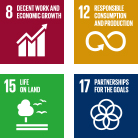
Results of initiatives
Agroforestry initiative
27farms
(covering a total area of
approximately 40 hectares)
(As of December 31, 2017)
Measures implemented at natural rubber farms
Support for natural rubber farms (YTRC)
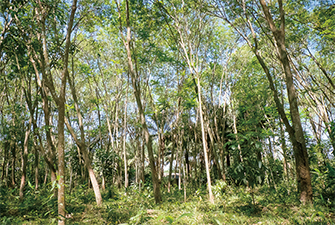
A farm that practices agroforestry
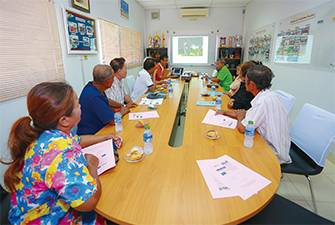
Dr. Sara Bumrungsri giving a seminar
In order to ensure sustainable procurement of natural rubber,
which is an important raw material for the manufacturing of tires
and other rubber products, Y. T. Rubber Co., Ltd. (YTRC) is providing
support to encourage the widespread adoption of the agroforestry
method. Agroforestry involves the inter-cropping of a variety of
different crops and tree species on the same farm. The agroforestry
approach offers many benefits; for example, the farmer can enjoy a
stable income from the harvesting of multiple different crops,
including natural rubber, fruit, lumber, etc., and this approach also
helps to improve biodiversity within the farm.
From the time when a rubber tree sapling is planted, it takes
around 5–8 years of growth before latex can be harvested from the
tree. With agroforestry, the farmer will have other sources of
income from other crops during this period. A further point is that
the price of rubber tends to fluctuate dramatically depending on
market conditions; even after the rubber trees on a farm have
matured enough for the farmer to be able to extract rubber from
them, having a wide variety of other crops growing on the farm can
help to stabilize the rubber farmer’s income.
Rubber trees experience a period called “wintering” every year,
when the leaves fall off all of the rubber trees at the same time
before new leaves start to grow. Outside this period, the leaves
tend not to fall off, so once the leaves that fell off during the
wintering period have been decomposed by insects and
microorganisms, etc., there is nothing left to cover the soil, which
as a result tends to become very dry. If a variety of different plants
are inter-planted together, the soil will always have fallen leaves
covering it, which will protect the soil from becoming too dry. The
decomposition of the fallen leaves also provides free fertilizer for
the rubber trees, contributing to a reduction in costs for the farmer.
Rubber trees are affected by a disease called white root disease
(WRD), the risk from which is particularly high in Southeast Asia.
Once a rubber tree becomes infected with WRD, the disease can
spread to other nearby trees very rapidly, and when WRD has been
in the soil, that area of land cannot be used to cultivate rubber
trees for at least five years. On agroforestry farms, because a wider
variety of different plant species are being grown, the range of
microorganisms in the soil is much more complex, and it is believed
that this makes it more difficult for WRD to gain a foothold.
With assistance from Dr. Sara of the Prince of Songkla University,
a noted expert in the field of agroforestry, YTRC has organized
agroforestry seminars for natural rubber farmers in and around the
Surat Thani district, acting as liaison between Dr. Sara and the
farmers, and providing venues for the seminars. Dr. Sara’s research
has shown that farms that practice agroforestry have higher yield
and higher income than conventional natural rubber farms.
However, because the number of case studies is still relatively
small, YTRC has been striving to get more farmers to adopt the
agroforestry practices. When YTRC first launched this project in
2016, there were 10 participating farms, with a total area of
approximately 12 hectares; by 2017, this had increased to 27 farms,
with a combined total of around 40 hectares. It is anticipated that,
by 2020, farms with a combined land area of around 180 hectares
will be practicing agroforestry.
In 2017, the direct support provided to farmers by YTRC included
the provision of approximately 4,000 saplings and around 10 tons
of compost. The saplings were cultivated in nursery located within
the YTRC factory grounds using seeds collected by YTRC
employees. The compost was made using sediments that are a
by-product of the natural rubber manufacturing process, together
with grass cuttings from the factory grounds and food waste from
the factory cafeteria, etc.
- [VOICE] An agroforestry farmerMr. Prajub Nuphet
-
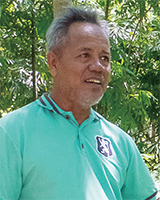
It is now eight years since I first started using the agroforestry approach in a corner of my natural rubber farm. When I first heard about agroforestry, my immediate reaction was “That sounds like a really great agricultural technique!”
After implementing agroforestry for a few years, I stopped using chemical fertilizers altogether. The crops that I have planted on the farm include fruit trees, plants that are used to make spices, and trees the wood from which can be used to make furniture, etc. Not only has adopting agroforestry helped to give me a more stable income, the fact that I am doing something which is beneficial for everyone makes me feel very proud.
Over the past few years, rapid development in the Surat Thani district has led to a decline in the number of wild animals. However, since I started implementing agroforestry, there has been a pronounced increase in the number of butterflies and other insects, wild birds, etc. on the farm. In addition, although it hardly rains at all in Surat Thani during the dry season, the fallen leaves from the additional tree species help to retain moisture, so the soil doesn’t dry out.
I am very grateful to YTRC for providing the seedlings. There is a lot that I don’t know about agricultural techniques and market conditions in relation to crops other than natural rubber, so it would be great if I could access this kind of information. In the future I plan to start growing an even wider variety of crops, including coffee, vegetables, etc., and I hope to become an agroforestry expert so that I can transform my farm into a learning center.
TOPIC
Working towards sustainable
natural rubber procurement
Supply chain survey in Indonesia
In March 2018, we engaged in communication with small-scale natural rubber farmers (smallholders) on the island of Sumatra in Indonesia, in collaboration with Indonesian company PT. Kirana Magatara, a leading supplier of natural rubber. The latex from natural rubber trees is collected and the rubber component is extracted and processed in block form, which is used in the production of tires and other rubber products. Around 80% of natural rubber production derives from smallholders with a cultivable land area of less than 2 hectares. As an agricultural crop, the natural rubber harvest varies depending on the season and on weather conditions. The price of natural rubber also tends to fluctuate dramatically depending on international market conditions. The natural rubber supply chain is very complex, with 2–6 (or even more) intermediaries between the producer and the firms responsible for rubber processing and shipment in Indonesia. PT. Kirana Magatara is working to strengthen rubber farmers’ economic autonomy by providing them with knowhow that they can use to boost rubber yields and improve rubber quality. These efforts are also helping to conserve biodiversity and minimize the negative impact of climate change. By strengthening ties with stakeholders, these measures support sustainable value creation. As a user of natural rubber, Yokohama Rubber has been learning about PT. Kirana Magatara’s initiatives, and has been listening directly to the views of small-scale rubber farmers, with the aim of contributing to activities that can make natural rubber a sustainable resource.
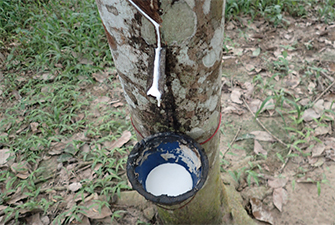
Natural rubber being harvested
We implement activities to reduce our environmental footprint on an ongoing, Group-wide basis

Results of initiatives
Greenhouse gas emissions
Scope 1 363,000t-CO2
Scope 2 354,000t-CO2
Scope 3 23,237,000t-CO2
(FY2017, consolidated)
Energy-saving measures are being implemented at all Yokohama Rubber tire production plants
In recent years, with the adoption of the Sustainable Development Goals (SDGs) by the United Nations and the adoption of the Paris Agreement at the 2015 United Nations Climate Change Conference (COP21), there has been growing demand from society for measures aimed at realizing sustainability. At the same time, investors and other stakeholders increasingly expect companies’ business strategies to be linked to their CSR strategies. In line with these trends, the Yokohama Rubber Group has also been implementing measures to foster energy saving and the use of renewable energy. In regard to energy conservation, it is important to make the necessary preparations for implementing practical measures in line with the company’s medium-term and long-term objectives, while striving to strike the right balance between greenhouse gas (GHG) reduction and maintaining profitability. The tire manufacturing process consumes large amounts of energy. The Facilities Administration Department provides support for energy-saving activities in a variety of areas, including the adoption of energy-efficient machinery (and upgrading existing machinery to make it more energy-efficient), reducing energy losses, etc. Tire manufacturing equipment and arrangements are constantly changing; in order to be able to monitor actual energy consumption during production more accurately, the Department is developing management systems that allow detailed, wide-ranging measurement, and will be reflecting the results of this measurement in its operations. Other important responsibilities of the Facilities Administration Department include formulating plans for realizing efficient operation of the electric power and power distribution equipment, boilers, water supply and waste water discharge equipment etc. in our factories, and drawing up measures for reducing GHG emissions deriving from air-conditioning coolant, etc. Over the last few years, we have gradually been expanding the scope of implementation of measures such as the installation of large-scale cogeneration (Combined Heat & Power) systems and switching over to different fuels for boiler operation to include not only plants in Japan but also our overseas factories. Implementing energy-saving initiatives overseas can be very challenging, but the benefits in terms of GHG emission reduction can be substantial, and we will continue to actively implement these measures. There is still considerable room for implementing further renewable energy measures, and we will continue to monitor new technology developments carefully with this aim in mind.
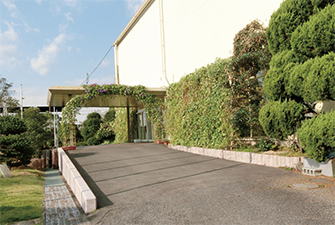
Green Curtain initiative at the Onomichi Plant
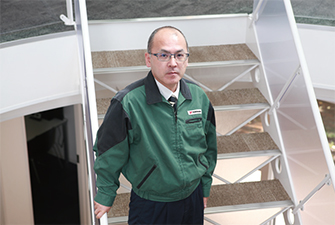
Kenji Ishii, Manager, Electricity & Measurement Section, Facilities Administration Dept.
Promoting the adoption of cogeneration systems
Yokohama Tire Manufacturing (Thailand) Co., Ltd. (YTMT), our
manufacturing facility in Thailand, began operation of a
cogeneration system that uses gas turbines and a waste heat boiler
to realize efficient electricity generation in May 2017; YTMT has
become the first overseas production location in the Yokohama
Rubber Group to install a cogeneration system.
By providing low-cost electricity and steam, cogeneration
systems help factories to both save energy and reduce costs. The
cogeneration system at YTMT is expected to reduce annual CO2
emissions by 9,300 tons (14%) compared to fiscal 2016, while also
reducing YTMT’s utilities expenses by 3–6%.
In Thailand, where the electric power supply is somewhat
unreliable, the cogeneration system can also function as an
emergency power supply in the event of a power cut.
As of 2017, cogeneration systems were in operation at three of
the Yokohama Rubber Group’s domestic production facilities in
Japan. By maintaining 24-hour operation, these cogeneration
systems provide 73% of the electric power consumed by the plants,
and they also provide almost all the steam needed by the plants;
they also contribute towards reducing CO2 emissions, and towards
reducing the amount of electric power needed from the power
companies, including a reduction in peak power demand.
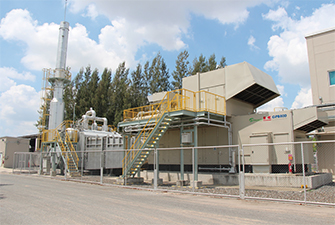
Cogeneration system at YTMT
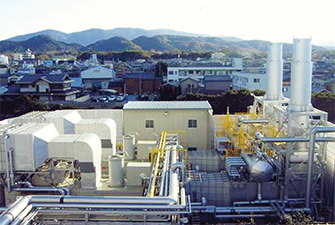
Cogeneration system at the Mie Plant
Adoption of photovoltaic electric power generation in India
In India, where atmospheric pollution is becoming an increasingly
serious problem, in order to realize an improvement in the
environmental situation while still maintaining economic growth,
there is a clear need to shift away from the use of fossil fuels such as
coal and petroleum towards natural energy sources that will help
to reduce CO2 emissions. The policies adopted by the Indian
government seek to promote the rapid adoption of photovoltaic
(PV) electric power generation as part of this shift.
In 2014, Haryana State, where Yokohama India Pvt. Ltd. (YIN) is
located, launched a PV development plan that aims to boost PV
electricity generation capacity in the State to 4,030 MW by 2022; as
part of this plan, YIN was asked to install PV capacity equivalent to
at least 8% of its contracted electric power usage (as of 2017).
YIN installed 625 PV panels, with a combined generating
capacity equivalent to 9% of the company’s contracted electric
power usage. As a result, over the period August 2017 – March 2018
YIN succeeded in reducing CO2 emissions by around 112 tons (this
calculation assumes that reducing electric power consumption by
1 kWh is equivalent to a reduction in CO2 emissions of 0.8 kg). On
sunny days, the PV panels have a combined generating capacity of
125 kW per day, although the average value is around 80 kW per
day. The electric power generated using the PV panels is used for
lighting, electrical sockets etc. within the factory, and thus
contributes towards reducing YIN’s electricity charges.
There are plans to expand the scale of the YIN factory, which in
turn will lead to an increase in the amount of PV generating capacity
that YIN is required to install. YIN is planning to increase the capacity
of its PV system by March 2022 in order to meet this requirement.
There is a display monitor at the YIN factory’s reception building
that shows how much electric power is being generated by the PV
system, thereby helping to
stimulate environmental
awareness. Through this
project, YIN is contributing
towards environmental
improvement in India.
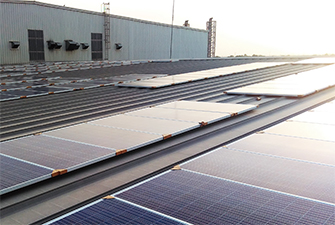
Solar panels installed on the roof of a building
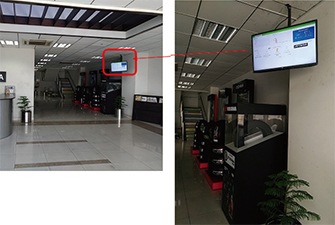
The display monitor at the factory’s reception building showing the amount of power generated by the PV system
TOPIC
Switching over to gas boilers
Recognizing the seriousness of the problem of atmospheric
pollution, in 2017 the Chinese government introduced new
measures to regulate emissions of coarse particulate
matter from factories. Shandong Province has followed
suit, and although Shandong Yokohama Rubber Industrial
Products Co., Ltd. (YRSC) had already fitted coarse
particulate matter removal devices to its coal boilers in
fiscal 2016, in March 2017 the municipal government of
Weifang City, where YRSC is situated, issued a notification
requiring that all coal boilers of 10-ton capacity or smaller
located within the City be dismantled; in response, YRSC
decided to replace its coal boilers with gas boilers and also
switch over from steam to oil as the heat transfer medium.
Using oil – which has superior charging efficiency – as the
heat transfer medium means that, by having the oil circulate
once it has been heated up, temperature loss can be
controlled, and less gas is needed than when coal is used as
the heat transfer medium. The new gas boilers began
operation in October 2017, with the target noted below.
In the future, YRSC will
continue to collect
information regarding
environmental policies and
guidelines, and will work
proactively to address
environmental issues.
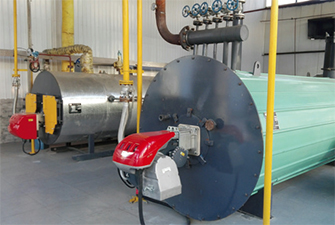
The new gas boilers
Heat loss with steam and heat-transfer oil compared
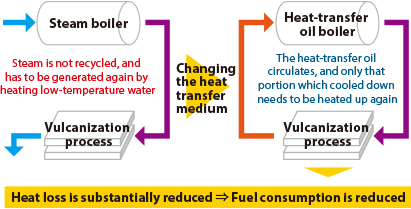
YRSC’s targets
Reduce CO2 emissions per unit of output by at least 45% in FY2018 compared to the base year (FY2017)

